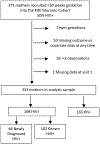HIV infection and increased food insecurity are associated with adverse body composition changes among pregnant and lactating Kenyan women
- PMID: 30185898
- PMCID: PMC6668710
- DOI: 10.1038/s41430-018-0285-9
HIV infection and increased food insecurity are associated with adverse body composition changes among pregnant and lactating Kenyan women
Abstract
Background/objectives: Body composition changes markedly during reproduction. In sub-Saharan Africa, impacts of HIV infection on body composition across pregnancy and lactation in the context of Option B+ antiretroviral therapy are unknown. Therefore, we sought to evaluate the role of HIV infection on body composition during pregnancy and lactation among Kenyan women.
Subjects/methods: A cohort of pregnant women (n = 333; 50.5% HIV+, receiving ART) were enrolled at seven clinics in western Kenya. Two prenatal (mean ± SD: 23.6 ± 4.4 and 33.4 ± 2.0 weeks gestation) and three postpartum (6, 14, and 36 weeks) measurements included: individual-level food insecurity, height, weight, fat mass (FM), and fat-free mass (FFM) by bioimpedance analysis (BIA), mid-upper arm circumference (MUAC), and triceps skinfold (TSF), allowing for AMA (arm muscle area) and AFA (arm fat area) derivation. Multivariable longitudinal regression models were used to relate HIV to body composition changes.
Results: In longitudinal models, HIV-infected women had lower weight (ß = -3.0 kg, p = 0.003), fat mass (ß = -1.5 kg, p = 0.02), fat-free mass (ß = -1.5 kg, p = 0.01), TSF (ß = -2.6 mm, p < 0.001), AFA (ß = -3.9 cm3, p < 0.001), and MUAC (ß = -1.0 cm, p = 0.001), but not AMA (p = 0.34), across all observations. Food insecurity was inversely associated with AMA and MUAC postpartum (AMA ß-range = -0.47 to -0.92 cm3; MUAC ß-range = -0.09 to -0.15 cm, all p < 0.05).
Conclusions: HIV infection was associated with lower weight, fat mass, fat-free mass, TSF, AFA, and MUAC values during pregnancy and lactation, while food insecurity was intermittently associated with body composition. This suggests that pregnant and lactating women living with HIV and food insecurity could benefit from nutritional support.
Conflict of interest statement
Figures


References
-
- Butte NF, Hopkinson JM. Body composition changes during lactation are highly variable among women. J Nutr 1998; 128(2 Suppl): 381s–385s. e-pub ahead of print 1998/03/21; - PubMed
-
- Adair LS, Pollitt E, Mueller WH. Maternal anthropometric changes during pregnancy and lactation in a rural Taiwanese population. Hum Biol 1983; 55(4): 771–787. e-pub ahead of print 1983/12/01; - PubMed
-
- Ramlal RT, Tembo M, Soko A, Chigwenembe M, Tohill BC, Kayira D et al. Patterns of body composition among HIV-infected, pregnant Malawians and the effects of famine season. Matern Child Health J 2013; 17(2): 265–273. e-pub ahead of print 2012/03/08; doi: 10.1007/s10995-012-0970-6 - DOI - PMC - PubMed
-
- World Health Organization. Guideline on when to start antiretroviral therapy and on pre-exposure prophylaxis for HIV. WHO Press: Geneva, Switzerland, 2015. - PubMed
Publication types
MeSH terms
Substances
Grants and funding
- R01MH107330/U.S. Department of Health & Human Services | NIH | National Institute of Mental Health (NIMH)/International
- R01MH095683/U.S. Department of Health & Human Services | NIH | National Institute of Mental Health (NIMH)/International
- K99HD086304/U.S. Department of Health & Human Services | NIH | Eunice Kennedy Shriver National Institute of Child Health and Human Development (NICHD)/International
- T32DK091227; T32 DK007559/U.S. Department of Health & Human Services | NIH | National Institute of Diabetes and Digestive and Kidney Diseases (National Institute of Diabetes & Digestive & Kidney Diseases)/International
- P2C HD042849/HD/NICHD NIH HHS/United States
- T32 DK007559/DK/NIDDK NIH HHS/United States
- K24AI134326/U.S. Department of Health & Human Services | NIH | National Institute of Allergy and Infectious Diseases (NIAID)/International
- R00 HD086304/HD/NICHD NIH HHS/United States
- T32 DK091227/DK/NIDDK NIH HHS/United States
- K01 MH098902/MH/NIMH NIH HHS/United States
- K99 HD086304/HD/NICHD NIH HHS/United States
LinkOut - more resources
Full Text Sources
Other Literature Sources
Medical

